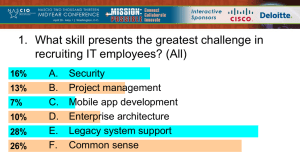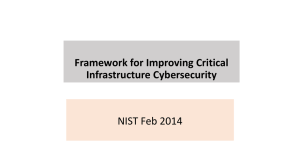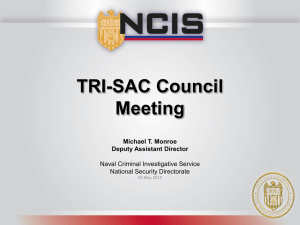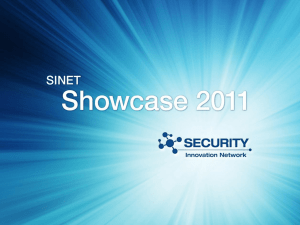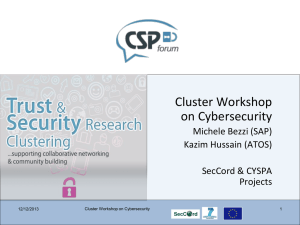National Initiative For Cybersecurity Education (NICE)
advertisement
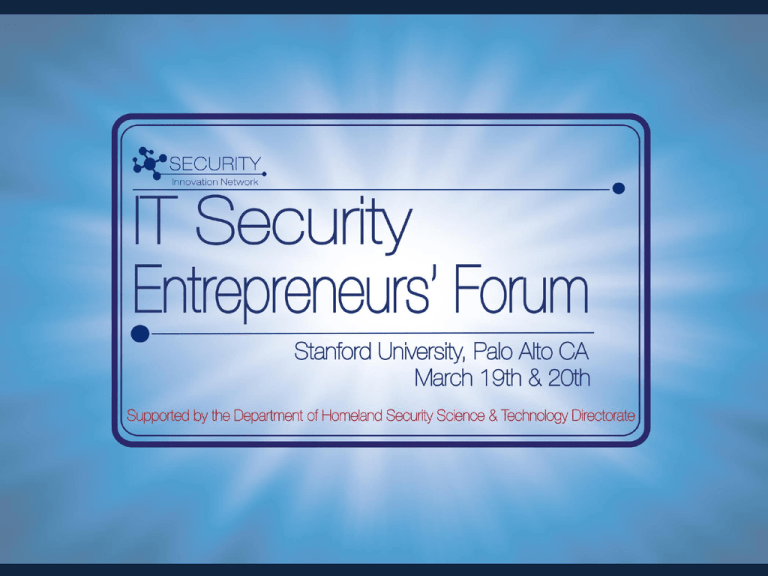
Though no-one knows for sure, corporate America is believed to lose anything from $100 billion to $1 trillion a year from online theft of proprietary information—trade secrets, research findings, internal costs, marketing plans, personal information, creditcard numbers, bank-account details and much more – Babbage (blog), The Economist, May 11, 2012 NIST’s Focus Computer Security Division (CSD) National Initiative For Cybersecurity Education (NICE) National Strategy for Trusted Identities in Cyberspace (NSTIC) National Cybersecurity Center of Excellence (NCCoE) Executive Order -- Improving Critical Infrastructure Cybersecurity NIST’s Cybersecurity Program CoreArea Focus Areas Core Focus Research, Development, and Specification Research, Development, and Specification ◦ Security Mechanisms (e.g. protocols, cryptographic, access control, Security Mechanisms (e.g. protocols, auditing/logging) cryptographic, access control, auditing/logging) ◦ Security Mechanism Applications Confidentiality Security Mechanism Applications Confidentiality Integrity Integrity Availability Availability Authentication Authentication Non-Repudiation Non-Repudiation System and Component configuration Secure System and Secure Component configuration Assessment and assurance of security Assessment and assurance of security properties of products and systems properties of products and systems Risk Management ◦ Continue to support the Joint Task Force Transformation Initiative (DoD, IC, NIST, CNSS) and support unified information security framework ◦ Continue support for risk management and information security publications ◦ Privacy and threat appendixes for SP 800-53, Revision 4 ◦ Work toward system and security engineering and application security guidelines Configuration Baselines ◦ Standardized security configurations for operating systems and automated tools to test the configurations, improving security and saving IT security management resources Security Automation and Vulnerability Management ◦ Continue to develop tools and specifications that address situational awareness, conformity and vulnerability management compliance etc Virtualization and Cloud ◦ Support for cloud special publication and standards activities to support security, portability and interoperability Key Management ◦ Foster the requirements of large-scale key management frameworks and designing key management systems ◦ Support transitioning of cryptographic algorithms and key sizes Next Generation Cryptography ◦ Open competition for new Hash algorithm ◦ Developing new, light weight, quantum resistant encryption for use in current and new technologies ◦ New modes of operation © Lisa F. Young/Dreamstime.com Secure Mobility ◦ Focuses on research and development in the area of mobile security including mobile application testing and mobile • Guidelines for Testing and Vetting Mobile Applications • Mobile App Software Assurance Requirements Supply Chain ◦ Work with industry, academic, and government stakeholders to develop foundational definitions, baseline requirements, general implementation methodologies, and a set of ICT SCRM best practices encompassing the system development lifecycle. Trusted Roots of Hardware o Collaborate with industry to develop guidelines that identify security properties for hardware trust roots Network Security o Foster requirements for secure networking technology such as DNSSEC, IPv6 and BGP technologies Security for Cyber Physical Systems o Collaboration with industry in developing, integrating, and utilizing cybersecurity standards and mechanisms capable of providing appropriate protection for CPSs ◦ Performing groundwork research to define factors that enable usability in the area of multifactor authentication and developing a framework for determining metrics that are critical to the success of usability Identity Management Systems ◦ Standards development work in biometrics, smart cards, identity management, and privacy framework. ◦ R&D: Personal Identity Verification, Match-On-Card, ontology for identity credentials, development of a workbench ◦ ID Credential Interoperability Infrastructure support ◦ Continued support for Health IT, Smart Grid and Voting Standards Development Organizations ◦ IETF ◦ IEEE ANSI ISO © Graeme Dawes | Dreamstime.com Usability of Security © Peto Zvonar | Dreamstime.com National Initiative For Cybersecurity Education (NICE) NICE will “enhance the overall cybersecurity posture of the United States by accelrating the availability of educational and training resources designed to improve the cyber behavior, skills, and knowledge of every segment of the population.” NIST, as the interagency lead for NICE, will promote the coordination of existing and future activities in cybersecurity education, training, and awareness to enhance and multiply their effectiveness. Raise national awareness about risks in cyberspace. Broaden the pool of individuals prepared to enter the cybersecurity workforce. Cultivate a globally competitive cybersecurity workforce. National Initiative For Cybersecurity Education (NICE) Raise national awareness about risks in cyberspace Improve knowledge of risks and vulnerabilities in cyberspace. Promote the use of cybersecurity resources and tools. National Initiative For Cybersecurity Education (NICE) Cultivate a globally competitive cybersecurity workforce Encourage the development and adoption of the National Cybersecurity Workforce Framework. Develop cybersecurity workforce forecasting tools. Establish standards and guidelines for cybersecurity training and professional development. Analyze and identify best practices to help organizations recruit and retain cybersecurity professionals. Evaluate the professionalization of the cybersecurity workforce. National Strategy for Trusted Identities in Cyberspace (NSTIC) President’s Cyberspace Policy Review (May 2009): a “cybersecurity focused identity management vision and strategy…that addresses privacy and civil-liberties interests, leveraging privacy-enhancing technologies for the nation.” Guiding Principles ◦ Privacy-Enhancing and Voluntary ◦ Secure and Resilient ◦ Interoperable ◦ Cost-Effective and Easy To Use NSTIC calls for an Identity Ecosystem, “an online environment where individuals and organizations will be able to trust each other because they follow agreed upon standards to obtain and authenticate their digital identities.” National Strategy for Trusted Identities in Cyberspace Pilots 2_ 2012 NSTIC Pilots: American Association for Motor Vehicle Administrators o AAMVA leads a consortium of private industry and government partners to implement and pilot the Cross Sector Digital Identity Initiative (CSDII) Criterion Systems o Allows consumers to selectively share shopping and other preferences and information to both reduce fraud and enhance the user experiences Daon o Demonstrates how senior citizens and all consumers can benefit from a digitally connected, consumer friendly ecosystem with multiple parties online Resilient Network Systems o Demonstrates that sensitive health and education transaction on the Internet can earn patient and parent trust University Corporation for Advanced Internet Development o Internet 2 is building a consistent and robust privacy infrastructure through common attributes National Cybersecurity Center of Excellence (NCCoE) Accelerated adoption of practical, affordable, and usable cybersecurity solutions Integrated cybersecurity solutions, built on commercial technologies, designed to address a sector’s specific business needs Increased opportunities for innovation through the identification of technology gaps Trusted environment for interaction among businesses and solution providers Further the understanding of current cybersecurity technology capabilities and the cost of their implementation Broader awareness of cyber security technologies and standards • y gaps technology capabilities and the National Cybersecurity Center of Excellence (NCCoE) Describe the Business Problem and Use Case Partner with the Communities o Partners from industry, government, academia and the IT community Implement and Test o Practical, usable, repeatable and secure cybersecurity platform n that addresses the business problem Transfer and Learn o Set of all material necessary to implement and easily adopt the platform Executive Order 13636 Improving Critical Infrastructure Cybersecurity Framework will consist of standards, methodologies, procedures and processes that align policy, business and technical approaches to allow organizations to achieve a sufficient level of cybersecurity performance and system resiliency. Incorporate voluntary consensus standard and industry best practices Technology neutral RFI - http://www.nist.gov/itl/csd/framework-022613.cfm First workshop April 3 THANK YOU Donna Dodson Division Chief, Computer Security Division Cyber Security Advisor Acting Director, National Cybersecurity Center of Excellence Donna.Dodson@nist.gov Computer Security Division Information Technology Laboratory National Institute of Standards and Technology Computer Security Resource Center: http://csrc.nist.gov
